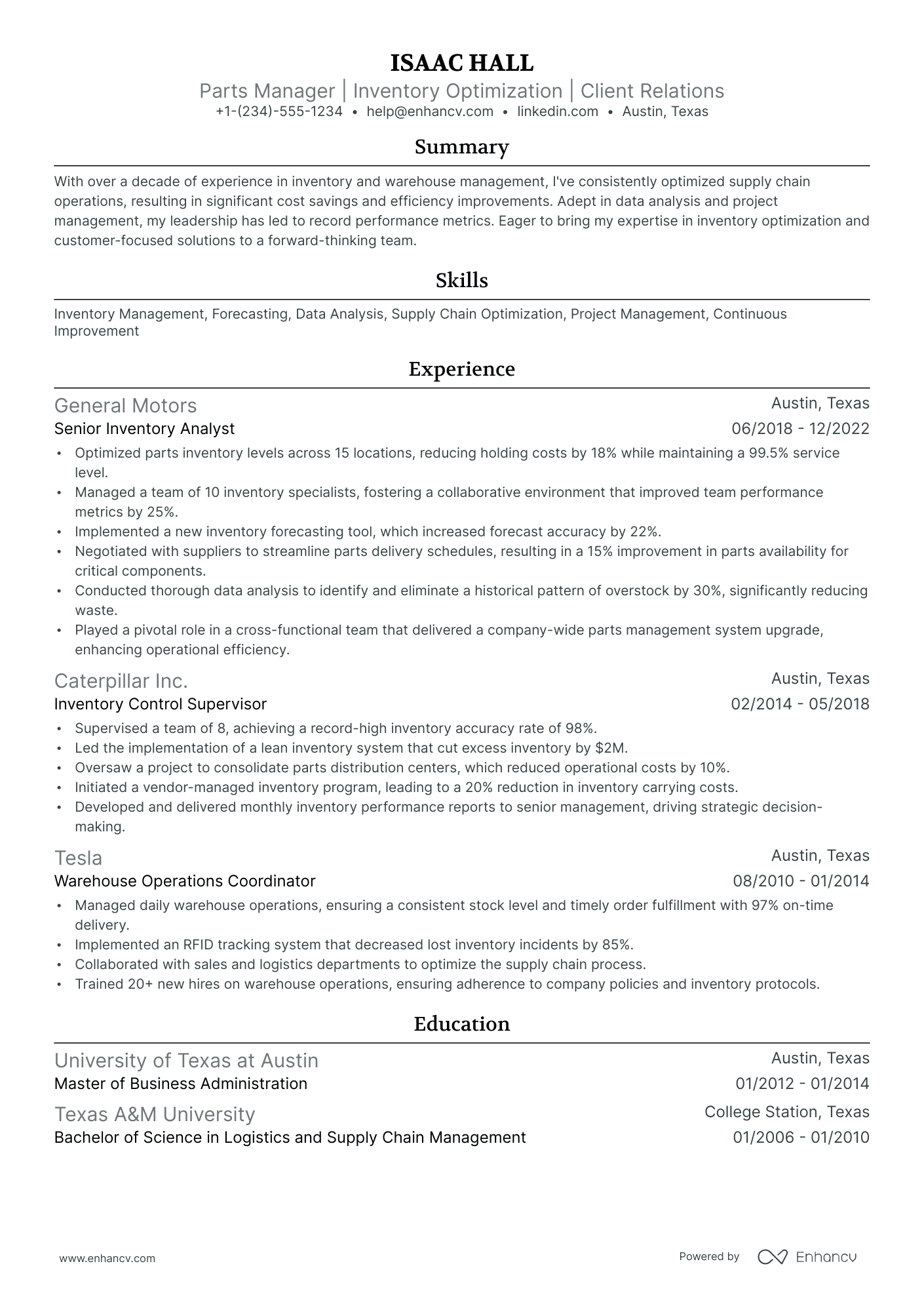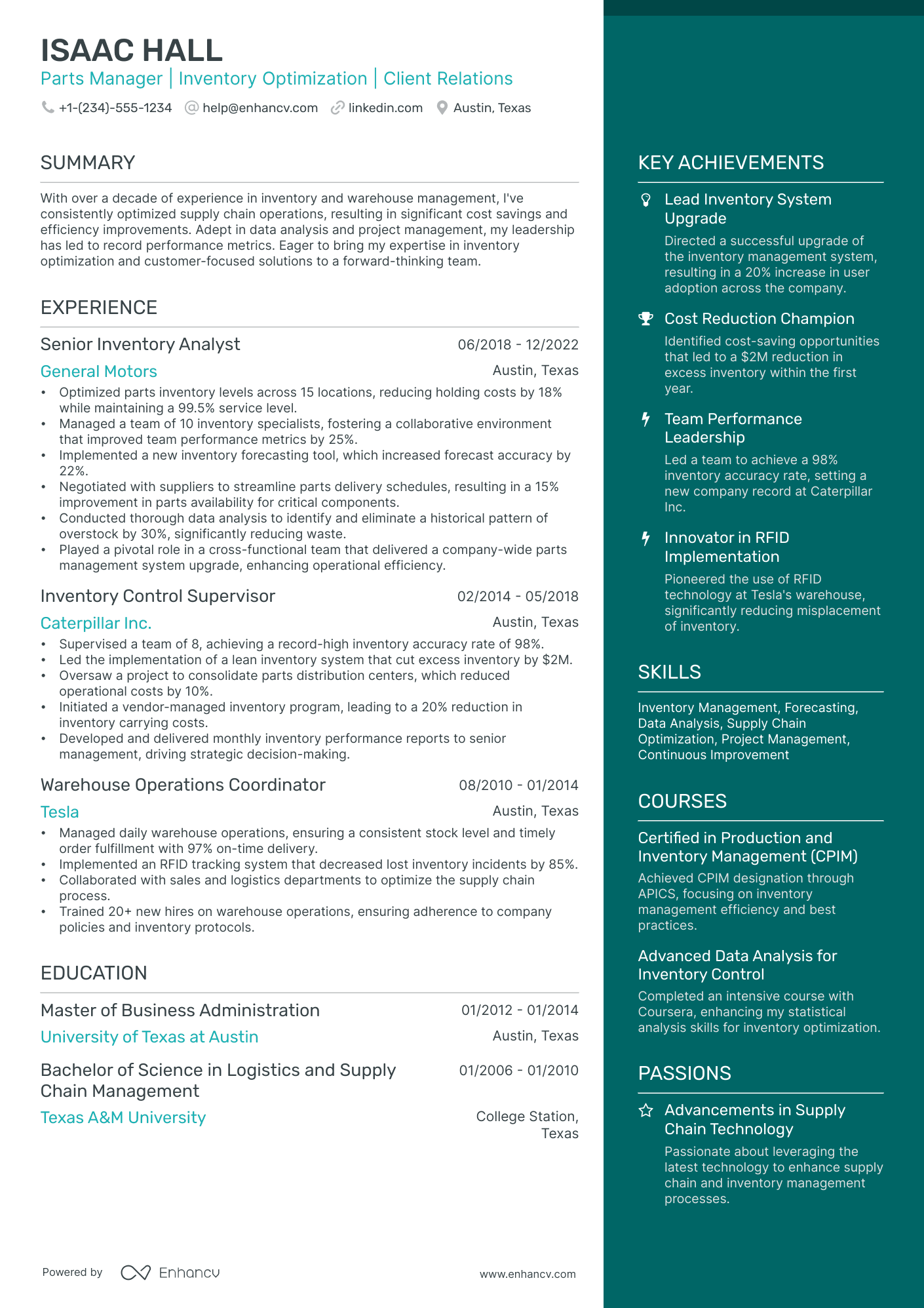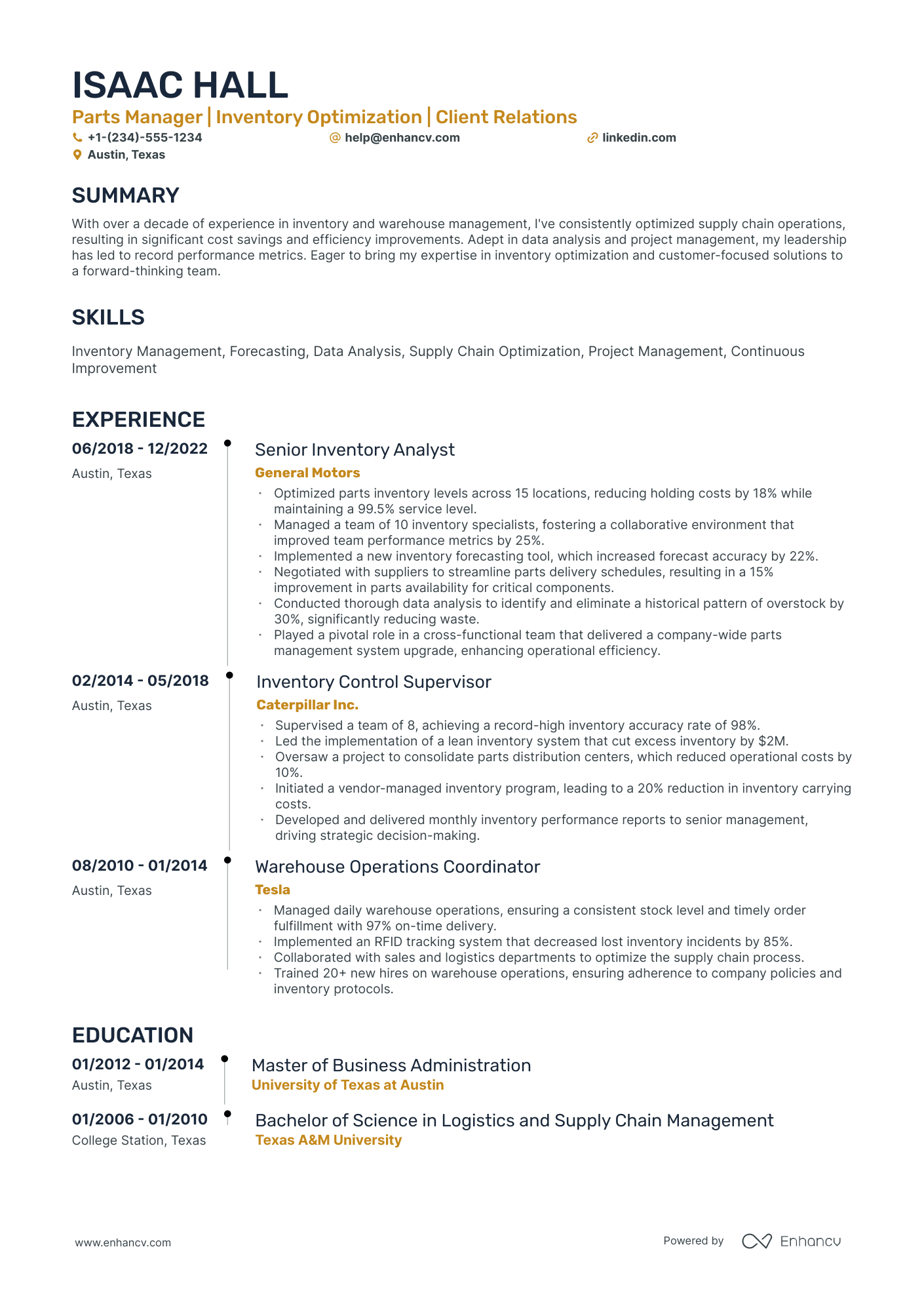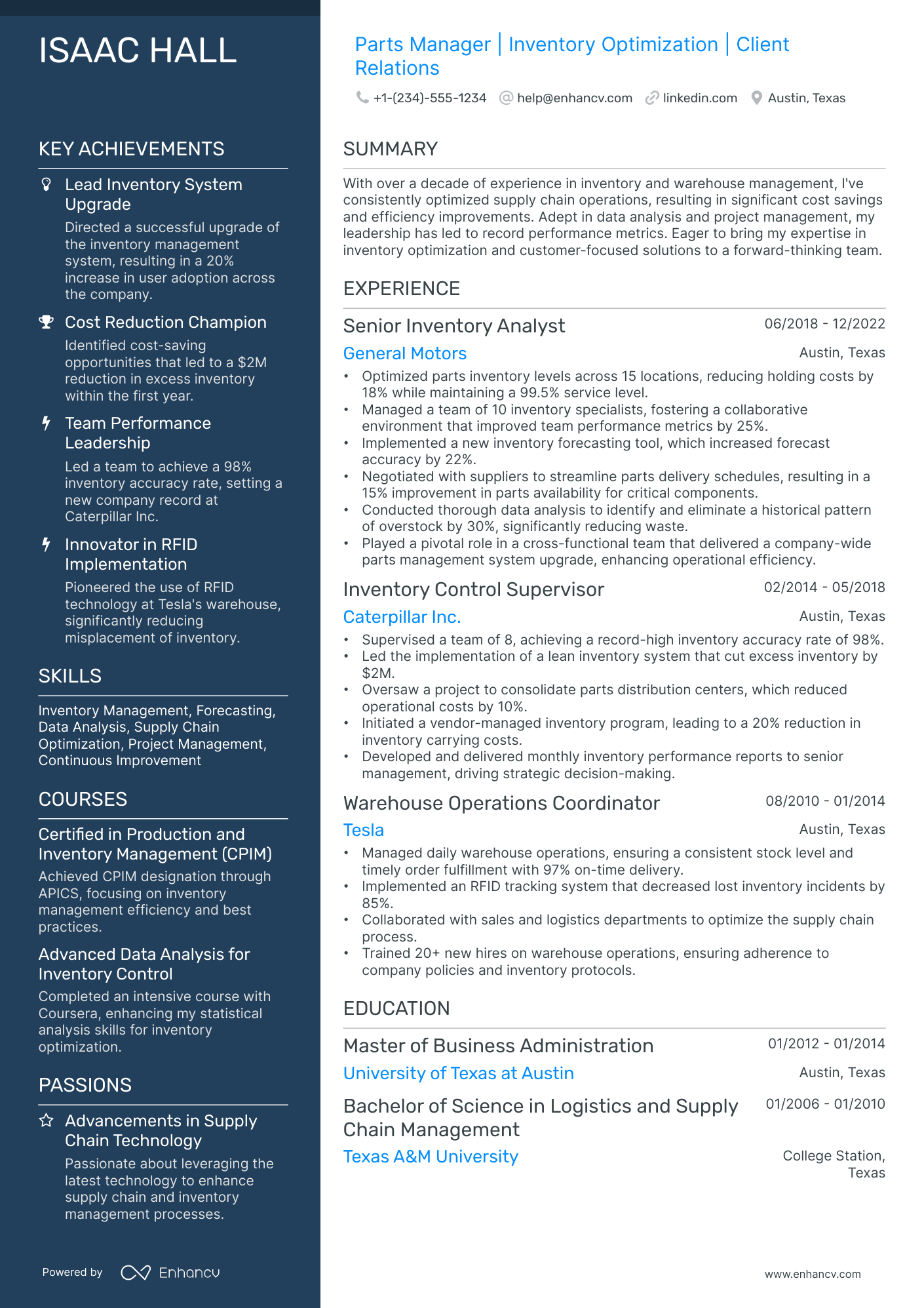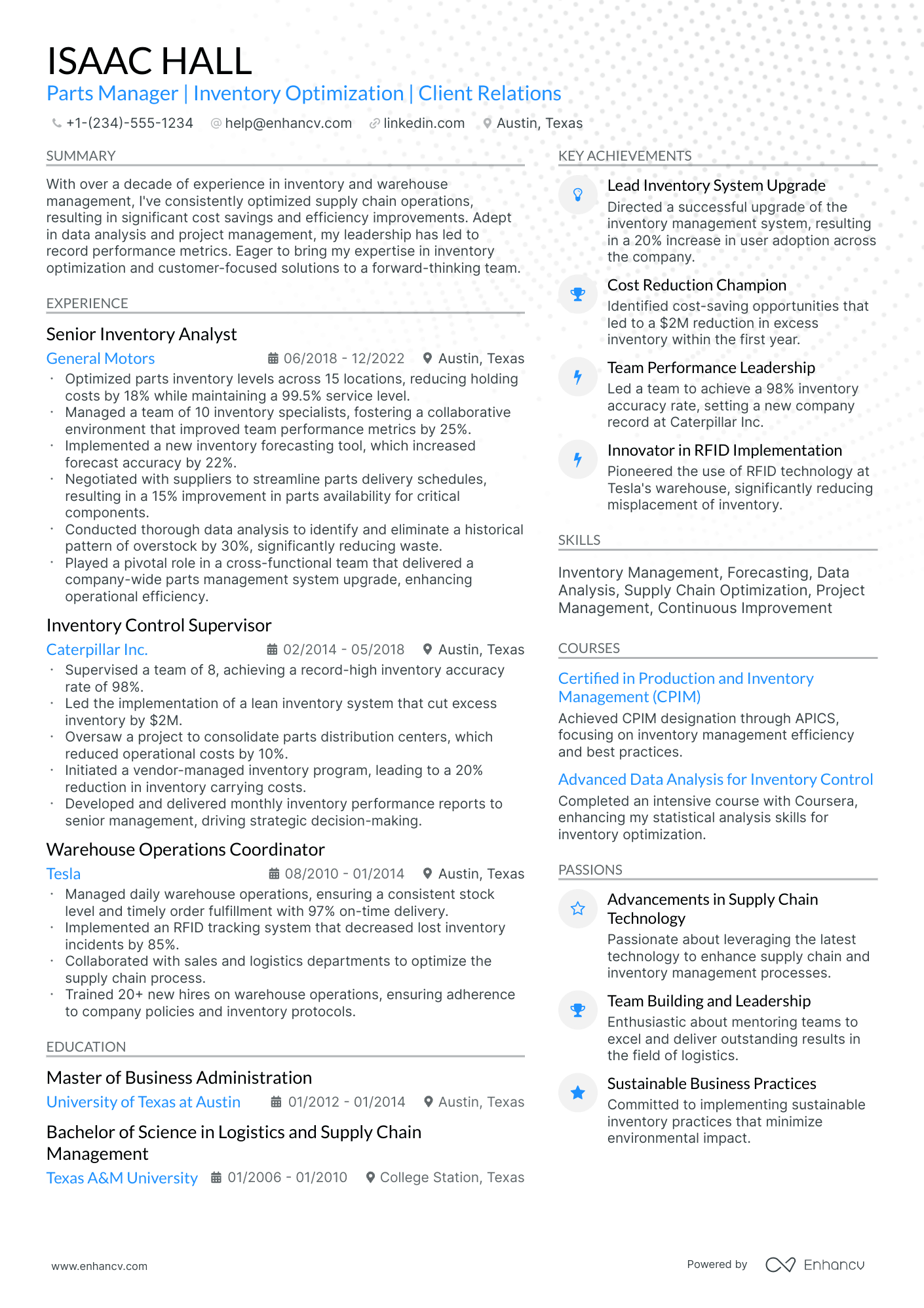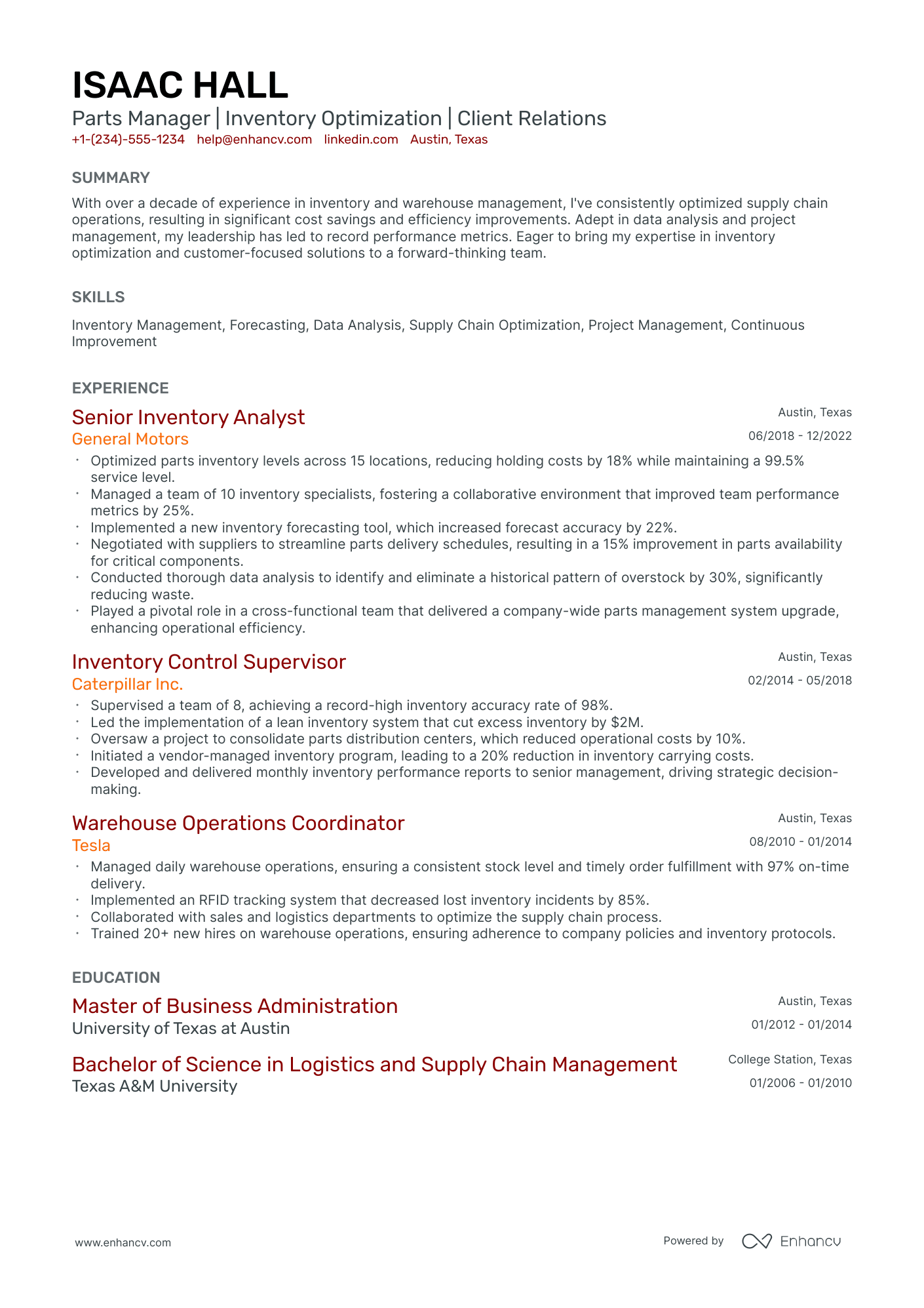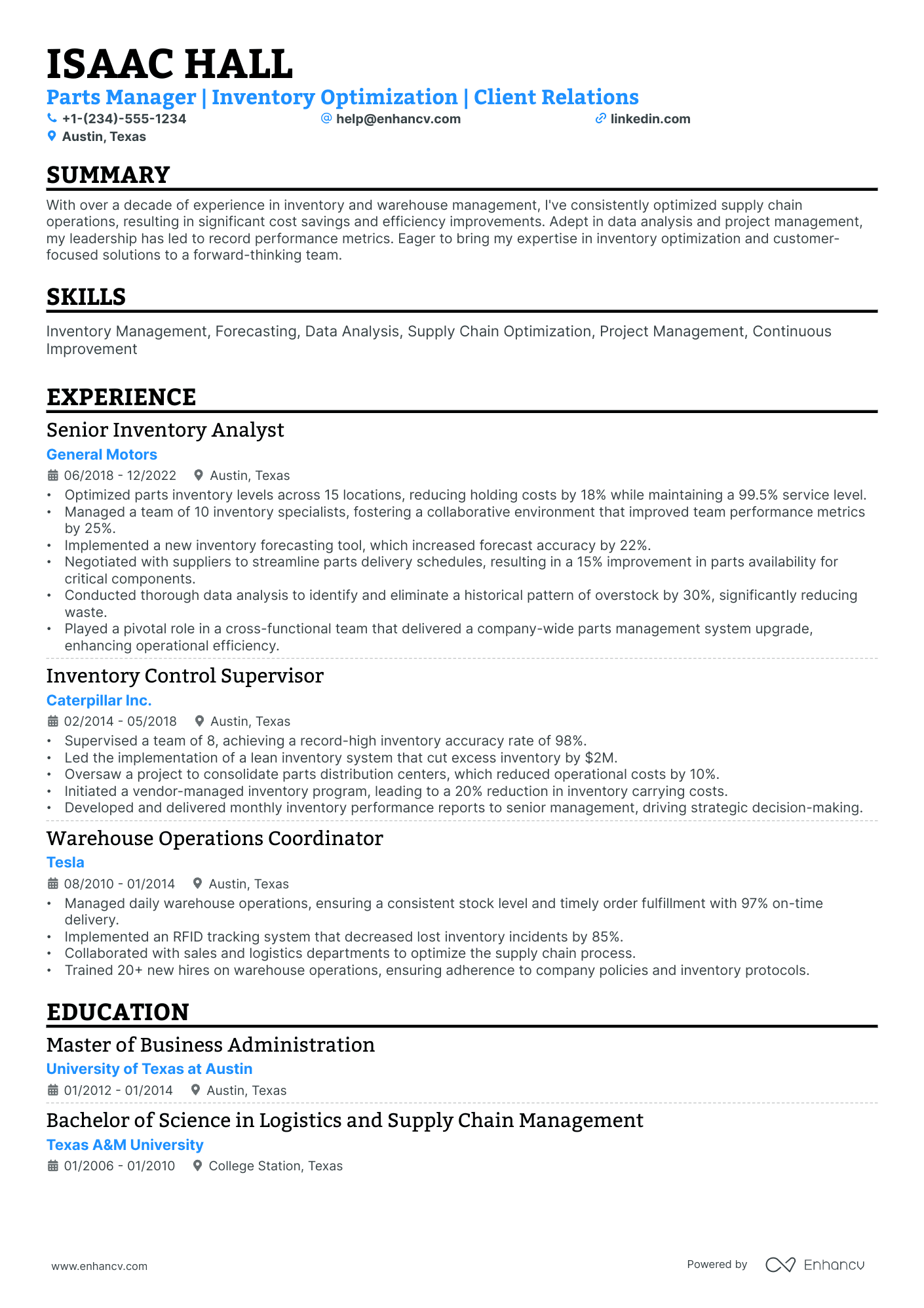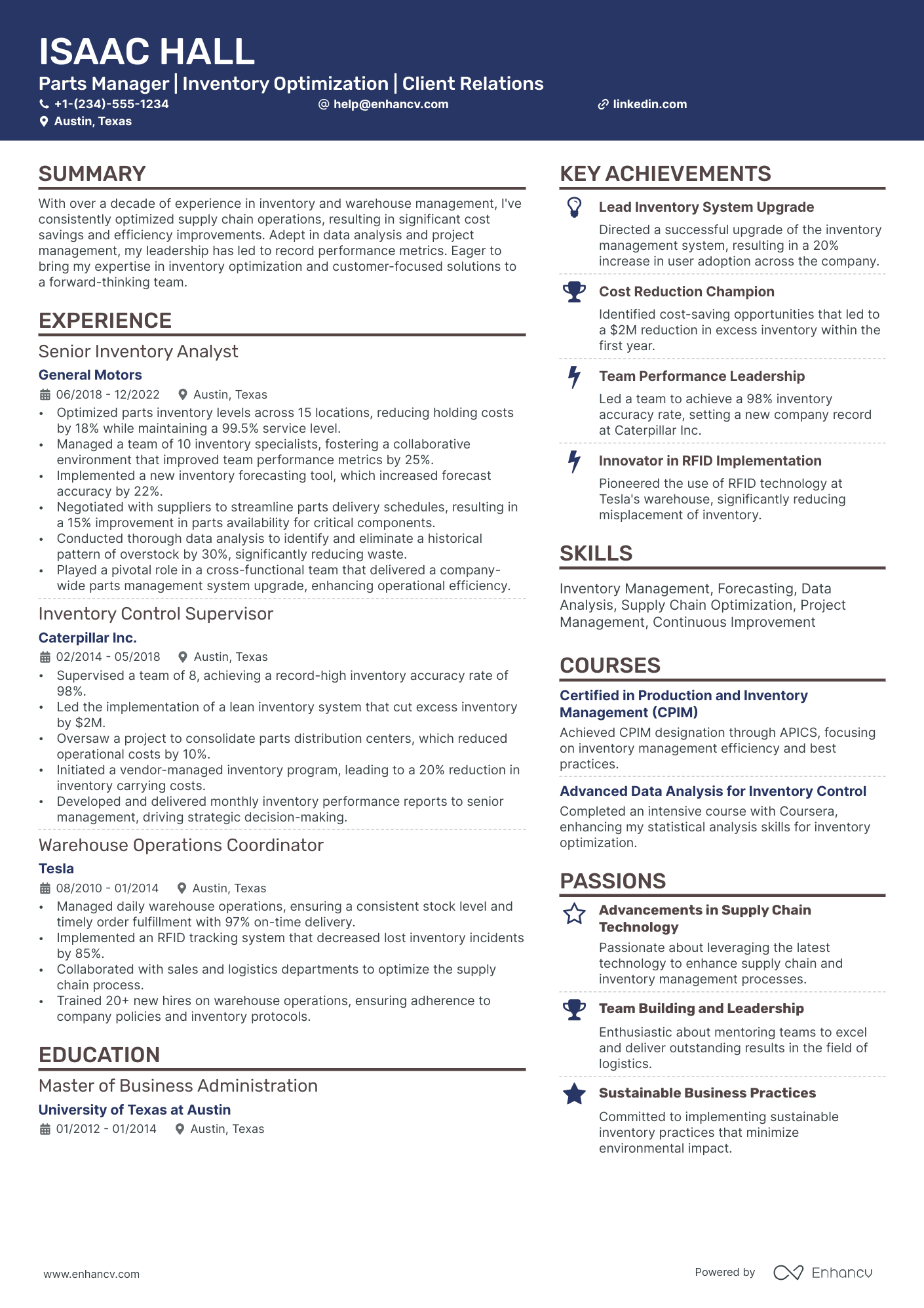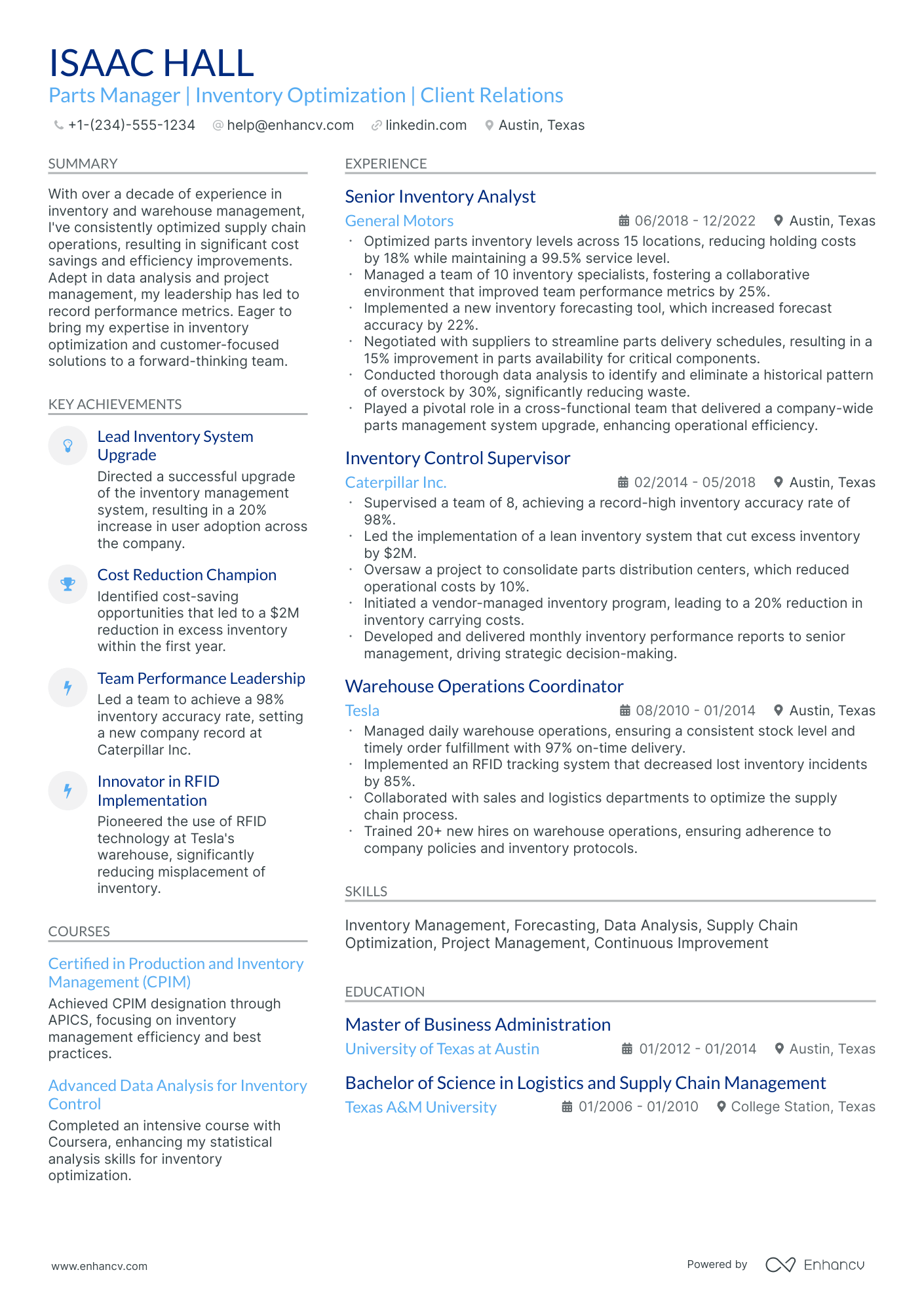As a parts manager, articulating your ability to manage complex inventory systems and lead a team effectively can be a daunting resume challenge. Our comprehensive guide is tailored to help you accentuate these key skills with proven strategies and relevant examples that will make your resume stand out to potential employers.
- Aligning the top one-third of your parts manager resume with the role you're applying for.
- Curating your specific parts manager experience to get the attention of recruiters.
- How to list your relevant education to impress hiring managers recruiting for the parts manager role.
Discover more parts manager professional examples to help you write a job-winning resume.
- Dispatcher Resume Example
- Manufacturing Technician Resume Example
- Manufacturing Manager Resume Example
- Assistant Production Manager Resume Example
- Delivery Manager Resume Example
- Production Coordinator Resume Example
- Vendor Manager Resume Example
- Warehouse Worker Resume Example
- Logistics Coordinator Resume Example
- Material Handler Resume Example
The importance of format and layout in your parts manager resume
Consider you're an HR professional at company X, evaluating two parts manager candidate resumes. John Smith presents a simple, traditional, and easy-to-read resume. Edward Price, however, uses a non-conventional, often illegible format. Whose resume would you spend more time on to understand their experience? This scenario underscores the importance of your parts manager resume’s design. It should be simply formatted and clearly communicate why you are the ideal candidate for the role.
Achieve this balance by:
- Listing your experience, beginning with the most recent and relevant, in reverse chronological order;
- Ensuring your header contains essential information, such as contact details, a headline, and a portfolio link. Include a professional photo in the parts manager resume header if you have one;
- Including only the most important and relevant resume sections to showcase your expertise and stand out from other candidates;
- Editing your parts manager resume to be no longer than two pages if you have extensive relevant experience. Use your limited resume space judiciously.
Also, remember that your parts manager resume might initially be scanned by an Applicant Tracker System (ATS).
When it comes to ATS:
- Opt for simple and legible fonts like Raleway, Rubik, Lato, etc., making your experience easy for the ATS to scan;
- Use serif and sans-serif fonts, both of which are ATS-friendly;
- Avoid overused options like Arial and Times New Roman, which, while suitable, may lack personality.
Contrary to a common myth, our recent study shows that the ATS can effectively process both one-column and two-column resumes. Learn more about this in the ATS myths guide.
Finally, when submitting your parts manager resume, always export it as a PDF to ensure all information remains intact, making the document easier to print, read, and scan.
Different markets have specific resume styles – a Canadian resume, for instance, may require a different approach.
Upload & Check Your Resume
Drop your resume here or choose a file. PDF & DOCX only. Max 2MB file size.
PRO TIP
If you happen to have some basic certificates, don't invest too much of your parts manager resume real estate in them. Instead, list them within the skills section or as part of your relevant experience. This way you'd ensure you meet all job requirements while dedicating your certificates to only the most in-demand certification across the industry.
The six in-demand sections for your parts manager resume:
- Top one-third should be filled with a header, listing your contact details, and with a summary or objective, briefly highlighting your professional accolades
- Experience section, detailing how particular jobs have helped your professional growth
- Notable achievements that tie in your hard or soft skills with tangible outcomes
- Popular industry certificates to further highlight your technical knowledge or people capabilities
- Education to showcase your academic background in the field
What recruiters want to see on your resume:
- Proven experience in inventory management and optimization to ensure parts availability and minimize overstock.
- Expertise in logistics and supply chain management to streamline parts sourcing and distribution processes.
- Strong vendor relationship management skills to negotiate better pricing and payment terms with suppliers.
- Demonstrated ability to implement and use inventory management software and other technologies to track parts effectively.
- Leadership experience in overseeing a parts department, managing staff, and ensuring team efficiency and productivity.
Experts' advice on writing your parts manager resume experience
While the excitement and motivation for writing your parts manager resume was present in the first hour (or so), you now find yourself staring at the blank page.
The resume experience section is the one that allows you to make a memorable impression by matching job requirement with your past jobs and accomplishments.
To help you write this resume section, here are four mistakes you need to avoid:
- Listing every job you have had so far, including the irrelevant ones. Before that, consider each of your past roles based on relevancy to the role. It may be the case that the job you had 15 years ago may have taught you invaluable skills that are appropriate for the role;
- Including irrelevant work experience items. Those are past jobs that aren't linked with the role you're applying for (or so they seem). Consider how your past jobs will serve your professional presentation: will they be filling in a gap in your work history, or just taking up space?
- Focusing on responsibilities instead of accomplishments. Your parts manager resume shouldn't just be telling recruiters what you did in the past - as it's most often the case that candidates have had similar responsibilities. But, rather, the experience section should showcase the success you've attained in each past role, thanks to your unique skill set;
- Consider listing just your professional experience. Any role you've had in the past - e.g. volunteering, internships, etc. - can make it into your parts manager resume experience section. Make sure to include it alongside numbers and results.
Two more things you need to remember about your resume experience section.
The first are keywords. Or those specific job requirements that are crucial for the role . Ensure you've integrated them across your experience section to get sorted closer to the ideal candidate profile by the Applicant Tracker System (ATS).
The second are action verbs. Each of your experience bullets should start with a strong action verb, followed by your specific skill and your on the job achievements. Follow this formula to hint to recruiters what your unique value as a professional is.
Still with us? In the next section, we will show you how industry-leading professionals have avoided the four most common mistakes, while integrating keywords and action verbs in their experience section.
- Oversaw the revamp of inventory management procedures, leading to a 25% reduction in back-order scenarios
- Implemented a novel barcode tracking system, improving parts traceability and reducing misplacements by over 30%
- Negotiated with suppliers to secure bulk purchase discounts, which cut parts costs by 15% annually
- Developed a just-in-time inventory system that correlated with service schedules, boosting parts availability by 40%
- Initiated a cross-training program, increasing departmental productivity by 20% and improving employee job satisfaction
- Managed a team of 10 parts specialists and optimized department workflows resulting in a 10% improvement in customer service ratings
- Spearheaded the implementation of an ERP system for improved parts management which decreased order processing time by 25%
- Curated tailored vendor relationships, enabling the on-boarding of advanced automotive technology parts into our inventory
- Launched an inter-departmental collaborative forecast initiative, enhancing order accuracy by 35%
- Facilitated the shift towards an online parts ordering system that expanded customer reach and increased monthly sales by 20%
- Conducted regular training for parts staff on new car models and technologies, maintaining high knowledge standards in the team
- Coordinated with service managers to synchronize parts and service needs, reducing average vehicle downtime by 15%
- Drove a significant increase in parts sales revenue by 30% through aggressive marketing and strategic partnerships
- Streamlined the return process for defective parts, elevating customer satisfaction rates by 22%
- Orchestrated the integration of a CRM system specifically tailored for parts tracking, enhancing data accuracy and customer follow-up
- Cultivated an analytics-driven stocking strategy which slashed excess inventory by 18% while maintaining a 98% fill rate
- Led the parts division through a period of record growth, achieving a 40% increase in part sales over two years
- Pioneered a sustainability initiative that recycled 90% of all unusable parts, reducing environmental impact
- Strategized and executed a comprehensive regional distribution network redesign, leading to a 15% increase in logistical efficiency
- Managed a regional team spread across five distribution centers, streamlining processes and enforcing consistent standards
- Played a critical role in the adoption of hybrid and electric vehicle parts into inventory, capturing a new market segment
- Increased procurement efficiency through the introduction of a centralized purchasing system, saving the company 12% on parts expenditure
- Established a parts forecasting model which aligned with fleet expansion plans, ensuring 95% availability for routine maintenance schedules
- Implemented supplier performance metrics that improved vendor delivery times by 20% and parts quality by 10%
The following content includes information from "O*NET OnLine" by the U.S. Department of Labor, Employment and Training Administration (USDOL/ETA). Used under the CC BY 4.0 license. The data represents the top responsibilities present on the task lists for parts manager professionals.
Top Responsibilities for Parts Manager:
- Provide customer service by greeting and assisting customers and responding to customer inquiries and complaints.
- Direct and supervise employees engaged in sales, inventory-taking, reconciling cash receipts, or in performing services for customers.
- Examine merchandise to ensure that it is correctly priced and displayed and that it functions as advertised.
- Monitor sales activities to ensure that customers receive satisfactory service and quality goods.
- Instruct staff on how to handle difficult and complicated sales.
- Assign employees to specific duties.
- Keep records of purchases, sales, and requisitions.
- Perform work activities of subordinates, such as cleaning and organizing shelves and displays and selling merchandise.
- Plan and prepare work schedules and keep records of employees' work schedules and time cards.
- Review inventory and sales records to prepare reports for management and budget departments.
Quantifying impact on your resume
- List the dollar value of inventory managed to demonstrate the scale of responsibilities and trust.
- Include the percentage reduction in inventory waste to highlight efficiency improvements.
- Mention the number of parts suppliers negotiated with to showcase negotiation skills and supplier management.
- State the exact number of direct reports to show management and leadership experience.
- Quantify the increase in inventory turnover rate to indicate successful inventory management strategies.
- Detail the percentage of on-time in-full deliveries to show commitment to meeting operational targets.
- Include the number of inventory audits performed to demonstrate attention to detail and compliance.
- Highlight the reduction of order lead time in percentage to showcase process optimization skills.
Action verbs for your parts manager resume
No experience, no problem: writing your parts manager resume
You're quite set on the parts manager role of your dreams and think your application may add further value to your potential employers. Yet, you have no work experience . Here's how you can curate your resume to substitute your lack of experience:
- Don't list every single role you've had so far, but focus on ones that would align with the job you're applying for
- Include any valid experience in the field - whether it's at research or intern level
- Highlight the soft skills you'd bring about - those personality traits that have an added value to your application
- Focus on your education and certifications, if they make sense for the role.
Recommended reads:
PRO TIP
If you're in the process of obtaining your certificate or degree, list the expected date you're supposed to graduate or be certified.
The heart and soul of your parts manager resume: hard skills and soft skills
If you read between the lines of the parts manager role you're applying for, you'll discover that all requirements are linked with candidates' hard skills and soft skills.
What do those skills have to do with your application?
Hard or technical skills are the ones that hint at your aptitude with particular technologies. They are easy to quantify via your professional experience or various certifications.
Meanwhile, your soft skills are more difficult to assess as they are personality traits, you've gained thanks to working in different environments/teams/organizations.
Your parts manager resume skills section is the perfect opportunity to shine a light on both types of skills by:
- Dedicating a technical skills section to list up to six technologies you're apt at.
- Focusing a strengths section on your achievements, thanks to using particular people skills or technologies.
- Including a healthy balance of hard and soft skills in the skills section to answer key job requirements.
- Creating a language skills section with your proficiency level - to hint at an abundance of soft skills you've obtained, thanks to your dedication to learning a particular language.
Within the next section of this guide, stay tuned for some of the most trending hard skills and soft skills across the industry.
Top skills for your parts manager resume:
Inventory Management Software
Automotive Parts Catalogs
Point of Sale Systems
Supply Chain Management Tools
Data Analysis Software
Warehouse Management Systems
Order Management Systems
Forecasting Software
Microsoft Excel
Customer Relationship Management (CRM) Software
Leadership
Communication
Problem Solving
Time Management
Customer Service
Team Collaboration
Attention to Detail
Negotiation
Adaptability
Organizational Skills
Next, you will find information on the top technologies for parts manager professonals from "O*NET OnLine" by the U.S. Department of Labor, Employment and Training Administration (USDOL/ETA). Used under the CC BY 4.0 license.
Top technologies for Parts Manager’s resume:
- Oracle Database
- Yardi software
- Apple Final Cut Pro
- YouTube
- CyberMatrix POS
- Plexis Software Plexis POS
PRO TIP
Always remember that your parts manager certifications can be quantified across different resume sections, like your experience, summary, or objective. For example, you could include concise details within the expertise bullets of how the specific certificate has improved your on-the-job performance.
Including your education and certification on your parts manager resume
The significance of your resume education section is paramount. It can show your diverse talents and experiences that are relevnt to the position.
- Incorporate educational qualifications, mentioning the institution and period.
- If you're on your academic journey, pinpoint your expected completion date.
- Opt for leaving out degrees that don't serve the job's purpose.
- Provide an overview of your educational experiences if it spotlights your milestones.
When recruiting for parts manager roles, candidates with relevant education and certification definitely stand out amongst competitors.
Showcase your academic background in the best way possible by:
- Listing all degrees and certifications that are part of the candidate qualifications in the parts manager advert
- Including any extra certificates, if they make sense to your application
- Not going over the top in details - the certificate name, institution, and dates are enough
- If you're in the process of obtaining a degree or certificate that's relevant to the job, include your expected graduation/certification dates
The education and certification sections help back up your application with years of experience in the industry or niche.
Select some of the most cutting-edge or applicable credentials for your next parts manager application from our list:
The top 5 certifications for your parts manager resume:
- Certified Automotive parts manager (CAPM) - Automotive Management Institute (AMI)
- Automotive Aftermarket Professional (AAP) - University of the Aftermarket
- Parts Specialist Certification (PSC) - National Institute for Automotive Service Excellence (ASE)
- Inventory Management Certification (IMC) - Association for Supply Chain Management (ASCM)
- Certified Professional in Supply Management (CPSM) - Institute for Supply Management (ISM)
The content below includes information from "O*NET OnLine" by the U.S. Department of Labor, Employment and Training Administration (USDOL/ETA). Used under the CC BY 4.0 license. The data represents the top associations for parts manager professionals.
Top US associations for a Parts Manager professional
- International Foodservice Distributors Association
- NACS
- National Automobile Dealers Association
- National Retail Federation
- Retail, Wholesale and Department Store Union
PRO TIP
Bold the names of educational institutions and certifying bodies for emphasis.
Recommended reads:
Practical guide to your parts manager resume summary or objective
First off, should you include a summary or objective on your parts manager resume?
We definitely recommend you choose the:
- Resume summary to match job requirements with most noteworthy accomplishments.
- Resume objective as a snapshot of career dreams
Both the resume summary and objective should set expectations for recruiters as to what your career highlights are.
These introductory paragraphs (that are no more than five sentences long) should help you answer why you're the best candidate for the job.
Industry-wide best practices pinpoint that the parts manager resume summaries and objectives follow the structures of these samples:
Resume summaries for a parts manager job
- With over 10 years of experience managing automotive parts inventories for high-volume dealerships, I have honed my skills in supply chain logistics, cost reduction strategies, and streamlining inventory systems to minimize waste and maximize efficiency. My leadership resulted in achieving a 30% reduction in surplus stock while maintaining a 99% parts availability rate.
- Dedicated professional with a 15-year tenure in aerospace parts management, demonstrating exceptional organizational skills, expertise in forecasting demand, and adeptness at vendor negotiations to secure competitive pricing. Successfully led a cross-functional team to revamp the inventory process, resulting in a 25% improvement in order fulfillment times.
- As a seasoned software project manager yearning for a career transition into parts management, I bring a unique blend of skills including process optimization, team leadership, and keen analytical abilities. My track in improving software deployment efficiency by 40% will be a valuable asset in streamlining parts management operations.
- Coming from a background in retail management, I am eager to transfer my strong organizational skills, customer relationship management, and supply chain coordination expertise to the field of parts management. While in retail, I oversaw a 20% year-over-year growth by implementing innovative inventory control systems and staff training programs.
- Eager to embark on a career in parts management, I am committed to applying my recent degree in Supply Chain Management and my passion for the automotive industry to effectively contribute to inventory accuracy, cost control, and supply chain efficiency, with the objective of driving significant process improvements.
- As someone with a fresh perspective and a recent graduate in Business Administration, my objective is to leverage my academic knowledge in operations management and intern experience in logistics to adapt quickly, support team objectives, and become a proactive member in a dynamic parts management environment.
Optimize your resume summary and objective for ATS
Drop your resume here or choose a file.
PDF & DOCX only. Max 2MB file size.
Average salary info by state in the US for parts manager professionals
Local salary info for Parts Manager.” Source: My Next Move, National Center for O*NET Development. Accessed 10/15/2024
| State | Average Salary (in USD) |
|---|---|
| US National Average | $46,730 |
| California (CA) | $48,140 |
| Texas (TX) | $43,410 |
| Florida (FL) | $47,410 |
| New York (NY) | $53,480 |
| Pennsylvania (PA) | $46,290 |
| Illinois (IL) | $47,260 |
| Ohio (OH) | $42,170 |
| Georgia (GA) | $43,720 |
| North Carolina (NC) | $46,070 |
| Michigan (MI) | $45,830 |
Beyond your parts manager resume basics - extra sections
Ensure your parts manager resume stands out from the crowd by spicing it up with a couple of supplementary sections that showcase your:
- Prizes - as a special nod to what matters most in the field;
- Projects - ones that would really further support your application;
- Hobbies - include only if you think they'd further your chances at landing the role with personality
- Community impact - to hint at the causes you care about.
Key takeaways
We've reached the end of our parts manager resume guide and hope this information has been useful. As a summary of our key points:
- Always assess the job advert for relevant requirements and integrate those buzzwords across various sections of your parts manager resume by presenting tangible metrics of success;
- Quantify your hard skills in your certificates and skills section, while your soft skills in your resume achievements section;
- Ensure you've added additional relevant experience items, such as extracurricular activities and projects you've participated in or led;
- Use both your resume experience and summary to focus on what matters the most to the role: including your technical, character, and cultural fit for the company.
